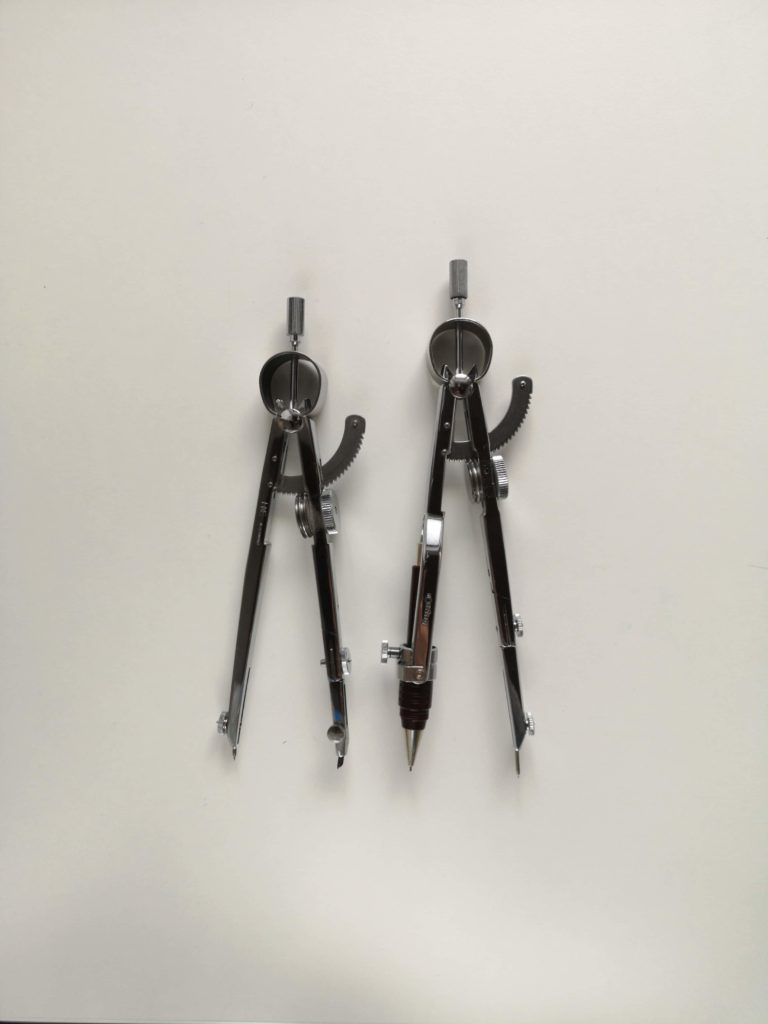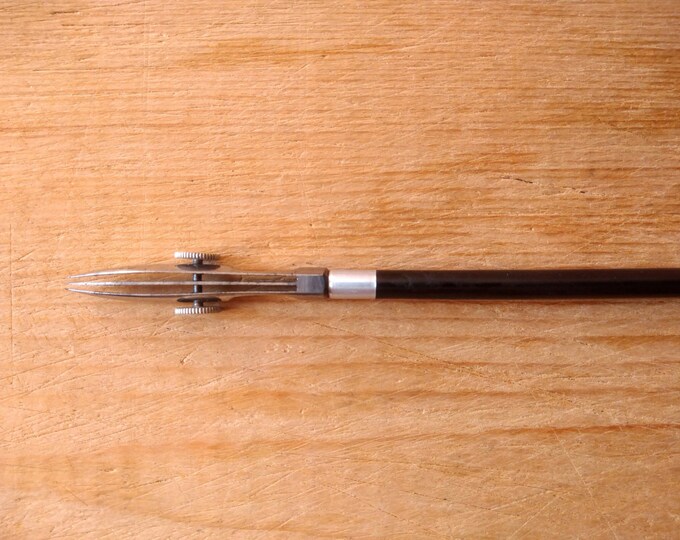
My first compass was a Staedtler, and I’ll be honest with you, I had no idea what a good drafting compass looked like back then.
I just went to an art shop and bought the first one I saw HA! As long as it had two legs, a steel point and a lead point, it was good for me.
No one ever told me what to look for when buying a compass, which are the various parts that the compass is composed nor which are the materials the compass should be made of.
That was until I had an interesting conversation with Alan Adams, who generously shared his knowledge with me.
Here I am now sharing all these valuable info with you all.
In this blog, I’m talking about the various parts of a typical 6-inch compass, which is the most common one.
1. HEAD JOINT
A head joint is what keeps the legs together. If the head joint is loose, the legs will move thus causing accuracy issues in your drawing. Pay attention to this part and make sure the head joint is tight and firm.
2. THUMB WHEEL
The best compass has a wheel between the legs. That wheel is what makes your compass adjustable but stable. Once you set the compass opening, the legs are not going to move because they are secured with a little tie rod. This kind of compass also has two kind-of buttons on the legs that you can press to open or close the legs instantly without rotating the central wheel
3. FOLDABLE LEGS
Another essential thing to look for is foldable legs. You should always bend the legs of the compass to keep them perpendicular to the paper. Otherwise, the pressure you put on the compass while using it will make the legs open up a little bit more, thus causing accuracy problems.
If you can’t bend the legs of your compass no problem, I got you covered. Search for a compass with an adjustable steel point. Almost every compass has a screw just above the steel point. In most compasses that screw allows you to extend the steel point but in some cases, you can also move the steel point left or right to keep the point vertical to the paper.
4. PEN ADAPTER
A pen adapter for a geometry lover is like Nutella for a food lover. To be able to use your favourite mechanical pencil with your compass instead of the large chunk of lead that comes with it, it’s such a blessing. Try it; you can thank me later.
5. MATERIALS
I know it’s tough to find a compass entirely made of steel because the only manufacturers that still make compasses nowadays (like Staedtler and Ecobra) use plastic but believe me, there is nothing better than a compass made of shiny stainless steel. I’m not saying this just because plastic looks odd but also because, unfortunately, plastic wears out very quickly and that can lead you to inaccuracy.
There are different types of drafting compass and these 5 things may not apply to all of them but you get the point.
If you want to know which compass I use, check my supplies list here
What Makes a Good Drafting Compass?
April 30, 2020



Hi Sandy
Excuse me if you have mentioned this previously, but all the vintage compasses I see don’t seem to have a pen adapter. Is there a standard size so you can fit a pen adapter to them and can you buy stand alone pen holders?
Many thanks
Vivien
Hi Vivien. You are right. Some of the vintage compasses (I think Rotring) have the pen adapter incorporated in the compass structure. This means that compass doesn’t have the lead point but it comes with a pen hole. But this is not always the case. In that case buy hard leads for the compass and sharpen them with a lead sharpener.
I am just trying to make sense of what Islamic Geometry and I absolutely like this detailed post on what to look for in a compass; however I would have appreciated if there some pictures to show the part you’re mentioning in each point.
Thanks so much for these invaluable tips; however as a beginner looking at photos of compasses on ebay or elsewhere, I cannot readily identify the many, many parts you mention are important and why. It would be immensely helpful if you could take a picture of each component part with a sharpie arrow indicating precisely what it is — circling it when possible — because otherwise I have no clue where on the compass to look for it.
Also I cannot tell by looking at it if it is a “locking” compass which is a feature i know I want. Again for all features if you could post a photo and circle with contrasting color what makes it be a “locking” compass that’d be great.
I know you said also to get bendable arms. No clue what that looks like or does not look like. I have looked for reviews on youtube but no one shows up close, saying THIS means it’s locking; THIS means it is not locking. 🙂 I did find an architect guy who seems beloved but he too does not give closeups of each feature.
Also you show in your shopping list a 3 inch spring compass but you also urge us to buy a bigger compass, But if we get a compass with extender, wouldn’t it draw the diameter that spring compass does?
If you could please think like a neophyte, going tiny step by step and why, that would be incredibly informative, even though I know you’re a longtime pro. I rather cringe at asking you all these questions but I’m certain others have the same as beginners. OR perhaps you can recommend a YT channel that does show all this with pics? Thank you again!
Finally, many of the vintage compasses you suggesting using — great tip, thanks — have many little compasses as part of a set. Are those little compasses useful and necessary? If they look “bent” is that a flaw or normal? If they are brass colored but surely not brass, is that good/bad? If so why?
Perhaps you could write an additional blog — hahaha – like you don’t have enough to do – with pictures explaining what constitutes a good vintage set or at least what to avoid? And with pics for every part, etc. I only want to buy one compass, not discover it is giving me 3 pieces I will never use, or it has 4 I use and is missing 3 essential ones but there’s no way I can discern that when I look at ebay sets of compasses. Thank you SO much for your kind wisdom as I brave the (greatly unexpected) perils of buying the right compass!
Hey Robin, thank you so much for your comment and for making me notice what is missing to my blog.
This is an old post an indeed I made a free guide about compasses showing the different parts in a picture http://sandykurt.com/types-of-compass-freebie
I don’t know what exactly you mean with “locking” but I guess it’s when the legs can’t move once you decide the radius. When a compass has a wheel between the legs that is an indicator of being “locking”. You can set the radius using the wheel and the legs won’t open or close as you use it.
Inside the guide you can also see what I mean with “bendable arms”
Usually the compass we all buy and use it’s a 6inch compass. The other types really depend on the use. If you need small circles you need a 3inch compass or a dropbow compass for very tiny circles. You can of course you the 6inch compass but it really depends on how accurate you want to be. If you need big circles you can either use beam compass or use the extension arm that comes with the 6inch compass. It all depends again on how accurate you want to be.
In the guide I explain each type of compass and their use so you can decide whether you need them or not. There is nothing to avoid. You just need to know if you need it or not and in the end even if you don’t need it now you might need it in the future so I don’t mind having extra compasses in my drawer.
I hope the guide will help you in your discovery. Have an amazing day